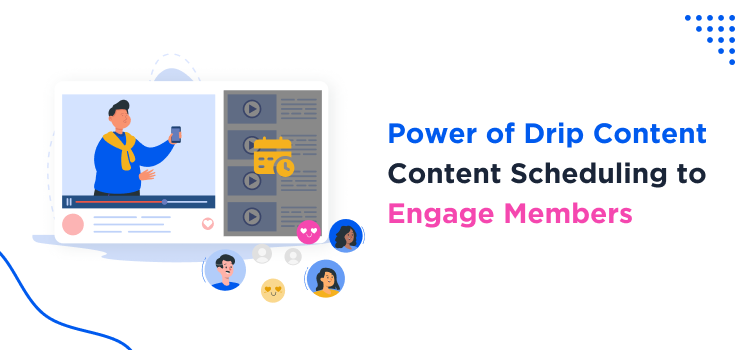Boost Member Retention with Drip Content Scheduling (Full Guide)

Content Dripping to Engage More Members

One of the easiest and most cost-effective ways you can engage with your market is through drip content.
Drip content is a marketing strategy in which pre-written messages are sent to customers or prospects over a specified period. These messages are typically automated and scheduled in advance, with the aim of nurturing leads, engaging customers, and guiding them through the sales funnel.
Your team can send drip content in many forms, such as emails, newsletters, social media posts, or educational materials. These are usually tailored to the recipient’s interests and behavior.
Anyone who uses drip content wants to build trust, authority, and convert. It is a useful email marketing tactic for businesses that want to expand their current audience list.
In this article, we will provide you with a step-by-step guide on engaging members with scheduled content releases. Through the power of drip content, you’ll be able to provide relevant and timely information to your audience.
Why Use Drip Content?
Why do marketers bother with creating deliberate and well-thought-out campaigns?
Beyond doing their best to convert and engage, drip content allows companies to do the following:
- Automated Nurturing: Marketers can set up drip content as scheduled, automated communication to save time and effort. This can free up resources for your other marketing initiatives.
- Personalized Communication: Drip content can be adjusted to deliver tailored content based on the preferences and behaviors of your market segments.
- Lead Nurturing and Conversion: Since Content Dripping aims to inform and engage, it helps audiences pass through the sales funnel with better knowledge of your product or service.
What are the Different Types of Content Dripping That Businesses Can Implement?
In 2023, the most popular type of email campaign was newsletters, used by 16.8% of marketers, according to Statista. But what if you want to go beyond traditional newsletters?
You can use some of these popular types of drip content:
- Educational Emails: Your team can use educational emails to provide potential leads and existing customers with information, tips, and resources related to your industry or niche to educate and inform your audience. These emails can help establish your company as an industry leader and build trust with your subscribers.
- Onboarding Sequences: Customizing drip content techniques helps to provide the correct information at the proper moment, thereby keeping consumers informed and involved. These enable a more straightforward, more direct approach by guiding new clients through the onboarding process without the requirement of cloud based learning management systems.
However, cloud-based learning management systems can offer further capabilities, such as interactive materials and progress tracking, thereby improving the learning environment. This type is most relevant when you want to grow your business with a membership website, as it adds an extra layer of customer service.
- Abandoned Cart Emails: Remind customers who have abandoned their shopping carts to complete their purchases with personalized emails that highlight the items left behind, offer incentives or discounts, and provide a seamless checkout experience.
Planning Drip Content
Planning out your drip content strategy comes in four parts:
1. Know Your Audience
Identifying the target audience is a crucial first step in planning a successful drip content campaign. This involves conducting thorough research to gain insights into the demographics, interests, and pain points of the audience.
2. Set Your Goals
You should also clearly define the goals and objectives that the campaign aims to achieve.
Some common goals include the following metrics:
- Lead generation
- Customer retention
- Product education
- Higher conversion rate
- Improved engagement metrics
3. Develop a Content Plan
Once the target audience and goals are identified, the next step is to develop a content plan that aligns with these parameters.
Content mapping involves mapping out the sequence of messages or content pieces to be delivered at each stage of the customer journey. This includes:
- Determining the topic of each content
- The format you will use
- Which channels will each content be launched in
4. Prepare a Timeline
While content mapping, you also need to establish a drip campaign timeline that can keep the momentum of the campaign. This timeline will need to be followed by your marketing team to the tee.
Identify the duration and frequency of the drip campaign while considering factors such as audience responsiveness and the length of the sales cycle. Make sure you also create a schedule for content creation, review, and deployment to maximize the impact of your drip content campaign.
Creating Drip Content for More Engagement

Choose the type of drip content that will resonate the most with your target audience.
Use the most compelling, informative, and valuable content you can produce, whether it’s articles, blog posts, videos, podcasts, infographics, case studies or drip course content. Some key strategies for crafting compelling content include:
- Writing Engaging Emails: When crafting email content, focus on writing attention-grabbing subject lines, personalized greetings, and concise yet informative body copy. Use storytelling techniques, compelling visuals, and clear calls to action like “Don’t miss out!”.
- Developing Interactive Content: Interactive content, such as quizzes, surveys, polls, or interactive infographics, can provide an immersive and engaging experience for your audience. You can encourage participation and feedback from users to foster a sense of involvement.
- Designing Multimedia Assets: Incorporating multimedia assets, such as videos, images, or audio clips, can add visual appeal and richness to your content. You should use high-quality visuals, engaging animations, and professional audio to create multimedia assets that effectively convey your message and resonate with your audience.
Personalize Your Drip Content
Personalization is key to delivering relevant and impactful drip content to your audience. After all, 62% of online customers said that a brand would lose their loyalty if it sent out a non-personalized email, according to a Statista survey.
Some effective personalization strategies include:
- Audience segmentation based on demographics or behavior
- Inserting personalized content or recommendations into your messages
- Addressing recipients by name and similar details.
You can use tokens on email marketing platforms to keep your content personalized. Just make sure you have enough information, such as the person’s name and preferences.
Ensure Consistency Across Drip Sequences
Consistency is essential for maintaining the effectiveness and coherence of your drip sequences.
Do your best to make sure that your content aligns with your brand voice, messaging, and visual identity across all touchpoints and interactions.
Keeping your tone, style, and messaging consistent throughout your drip campaign will reinforce your brand identity, build trust with your audience, and create a seamless user experience for your audience.
Publishing Drip Content
Follow these steps to make sure your drip content follows your schedule:Choose the Right Drip Campaign Software
When choosing the email marketing software, social media software or membership tool for your drip campaign, consider factors such as:
- Availability of core features like segmentation, automation, personalization, and campaign performance metrics tracking
- Ease of use
- Scalability
- Integration capabilities with other marketing tools
- Pricing
Set Up Your Drip Campaigns
Start by defining the parameters of each campaign. This typically includes:
- The target audience
- Your goals
- Content sequencing
- Timing
Use the features provided by the software to create automated workflows, set triggers for sending out messages, and personalize content based on recipient data.
Remember to test the setup thoroughly to ensure that all of the elements of your campaign are functioning as intended before launching the campaigns. For example, if you’re including a survey in your campaign, send it to a coworker first to see if they can access your survey.
Engage and Build Customer Loyalty
In conclusion, the power of drip content in engaging members through scheduled content releases cannot be overstated. Don’t let your marketing team miss out on the opportunity to secure leads for your sales team.
After all, a well-thought-out drip content strategy can efficiently nurture your leads and engage customers. It can also help guide them through the sales funnel to make it easier for your sales team to close deals.




Leave a Reply
You must be logged in to post a comment.